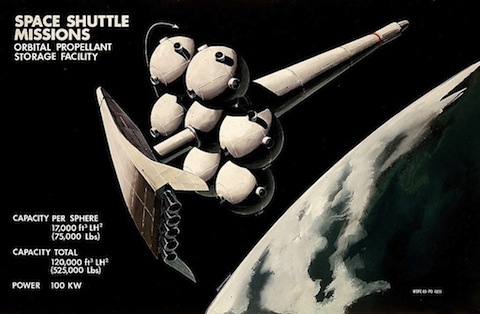
Back in 1985 or thereabouts, I made the worst business decision of my life: I traded all of my Star Wars action figures to a classmate, in exchange for a Fisher-Price Space Shuttle that made “beep beep” noises when a rubber buttons was depressed. To my credit, I realized within a matter of days that I had made a very unwise transaction, and I begged for a do-over. But my classmate informed me that Greedo and company had since been mangled and lost in his backyard. To this day, it brings great sadness to my heart to recall that early hoodwinking.
I’d like to think this early misstep was more a testament to my Space Shuttle obsession than raw stupidity. Like so many others who first became sentient during the Reagan Administration, I viewed the Space Shuttle as the ultimate emblem of mankind’s mastery over the universe. And because I lived in Los Angeles, I was treated to a noticeable sonic boom whenever a shuttle re-entered the atmosphere, destined for a landing strip at one of Southern California’s Air Force bases—bases where my father had served during his military career. You can only imagine how much I geeked out over the initial launch of Discovery, which will be lifting off for the very last time this afternoon.
Little did I know that the Space Shuttle was not initially conceived as a technological marvel, but rather something far less glamorous: a cost-cutting stratagem. When the project first burbled up from NASA’s ideas lab in 1969, it found favor with the Nixon Administration solely because it promised to slash the space agency’s budget. NASA Administrator Thomas O. Paine explained the logic in an interview that August—shortly after the very first artist’s concept of the shuttle (above) was released to the public:
One of the fundamental points of the second decade of space has to be innovations that will drastically bring down the cost of space operations. And the space shuttle vehicle that I mentioned, capable of going from the surface of the earth into orbit and back again as a reusable vehicle, is one of the keys to low cost.
At the present time, the lowest cost we have of putting a vehicle into orbit is a giant Saturn 5, and hte cost of that is about $8,500 per pound. Now we’re looking at the possibility of getting this down to $50 and eventually as low as $5 a pound.
Nixon bought NASA’s sales pitch, but the agency never came close to making good on those lofty promises of reduced costs. Quite the opposite, in fact—the Space Shuttle ended up costing roughly $20,000 per pound (in 1969 dollars) to get into orbit and then back down again. Perhaps NASA should have gone with its initial idea and refueled the vehicle from an orbiting gas station, as shown above?
More Space Shuttle concept art can be found here; I particularly like the long-rumored Soviet knock-off.


Tweets that mention The Money Pit | Microkhan by Brendan I. Koerner -- Topsy.com // Feb 24, 2011 at 11:08 am
[…] This post was mentioned on Twitter by Brendan I. Koerner, Koen Pellegrims. Koen Pellegrims said: RT @brendankoerner: The Space Shuttle was supposed to cost just $5 per pound to fly. NASA was off by a factor of 4,000: http://bit.ly/gtVF52 […]
scottstev // Feb 24, 2011 at 12:18 pm
Gregg Easterbrook did the definitive takedown of the shuttle program way back when.
I remember that FB “Adventure People” space-shuttle set myself. I bought my oldest some vintage/well-used “Adventure People” stuff earlier. He didn’t take to it as well as he should have.
Brendan I. Koerner // Feb 24, 2011 at 12:28 pm
@scottstev: This is the one I got in that trade–I now realize that it was called the “Alpha Probe,” presumably for legal reasons:
http://www.thisoldtoy.com/new-images/images-ok/300-399/fp325-alpha-probe.jpg
Seriously painful to recall that swap. In my top five dumbest moves of all time.
scottstev // Feb 24, 2011 at 12:43 pm
Yup, that’s the one. <a href="http://www.actionfigureinsider.com/blog/wp-content/uploads/SpyMagician/brainoid_and_friend.JPG"<Here are the bad guys from that same line. As I recall, the space line was the last gasp for Adventure People before getting boxed out by Star Wars, GI Joe, and gasp Transformers